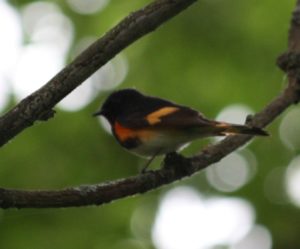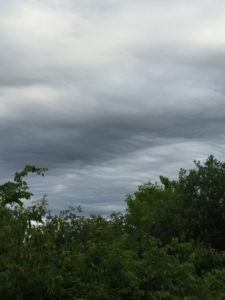Chip-chip-ch, d-d-d-d-dit. Two sedge wrens echoed each other’s songs in the marshy bottomland near the forks of the Baraboo River. I walked along the bike path, listening and taking notes.
A pair of rose-breasted grosbeaks came zooming down the path toward me, and then veered off into a tree over my left shoulder. The male, black and white with a scarlet bib, perched among the leaves and began to sing. I wrote that down.
Just at eye level, I noticed movement in the trailside brush. A little black warbler with bold orange markings and white belly – an American redstart – flitted from twig to twig. He had been singing over and over for several minutes: twee-ee, twee, twee, twee, CHEE-ah. As I walked away, he started up again. I made a note of his location, intending to return in a week or so to see if he succeeded in attracting a mate.
It was a gray day, and I might have stayed home with a good book. But I had a job to do. I am a volunteer for Wisconsin’s Breeding Bird Atlas II, a five-year, statewide survey of the birds that nest and reproduce in Wisconsin. Sponsored by a consortium of conservation organizations, the project will document not only which birds breed in the state, but how numerous and widespread they are, as well as the timing of their nesting efforts.
I have signed up to monitor two areas, or blocks, along the Baraboo River, each nine miles square. On regular morning visits, my task is to watch for birds and record their breeding activity. For example, a male bird singing to attract a mate or proclaim his territory is a “possible” indication of breeding; courtship displays suggest breeding is “probable”; nest-building activity means breeding is “confirmed.”
The Breeding Bird Atlas II will provide data that natural resource professionals and others can use to identify bird habitat that needs to be protected or perhaps improved. And the new information will show population changes that have occurred since 1995-2000, when Wisconsin’s first Breeding Bird Atlas was compiled.
But the atlas project doesn’t only help birds; I figure it helps me, too. Most importantly, atlasing trains me to pay closer attention to what birds are doing and to learn the behaviors of familiar and unfamiliar birds. So it deepens my understanding of what’s happening in the world around me.
Besides that, it gets me outside to visit the river on mornings when I might otherwise be tempted to stay in side and do something that can probably wait.
The redstart was still singing and the first few drops of rain were falling as I walked back to my car. My notebook was filled not only with observations of flirtatious catbirds and singing meadowlarks. I also had notes about butterflies, and what was in bloom, and about the gray squirrel that had hopped onto a nearby branch to scold me.
Almost always, I reflected, as I quickened my pace, I learn something new or see something I have never seen before. And in the end, I am always glad I went. I looked up and spied a Baltimore oriole on a bare branch, bits of dried grass bristling from her bill: material to build a nest. Confirmed. I paused and wrote it down.
To learn about volunteering for the Wisconsin Breeding Bird Atlas II, visit the Wisconsin Society for Ornithology’s website: http://wsobirds.org/volunteer.



